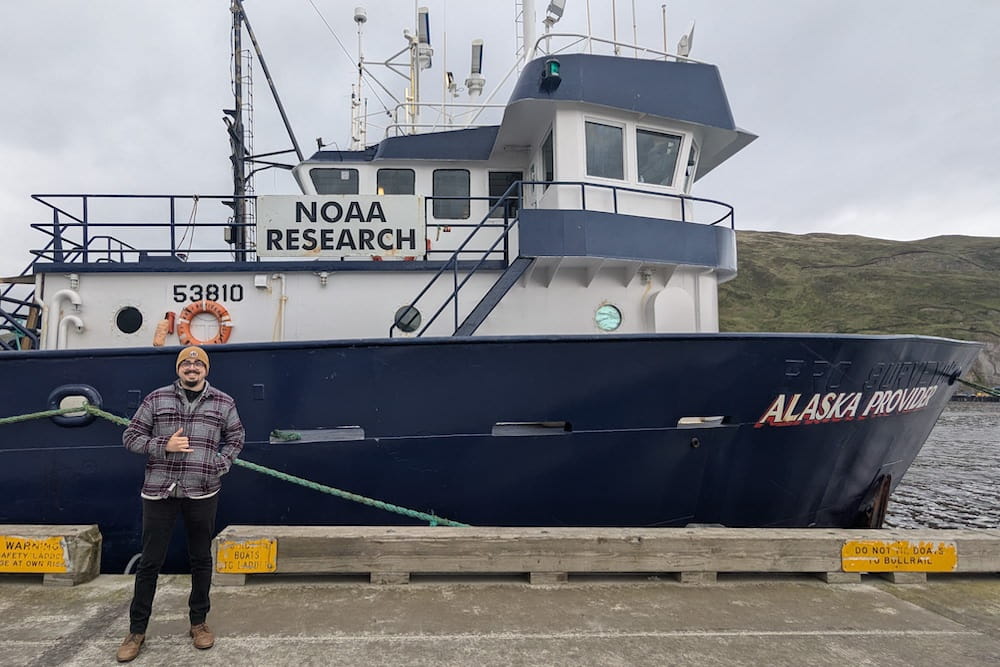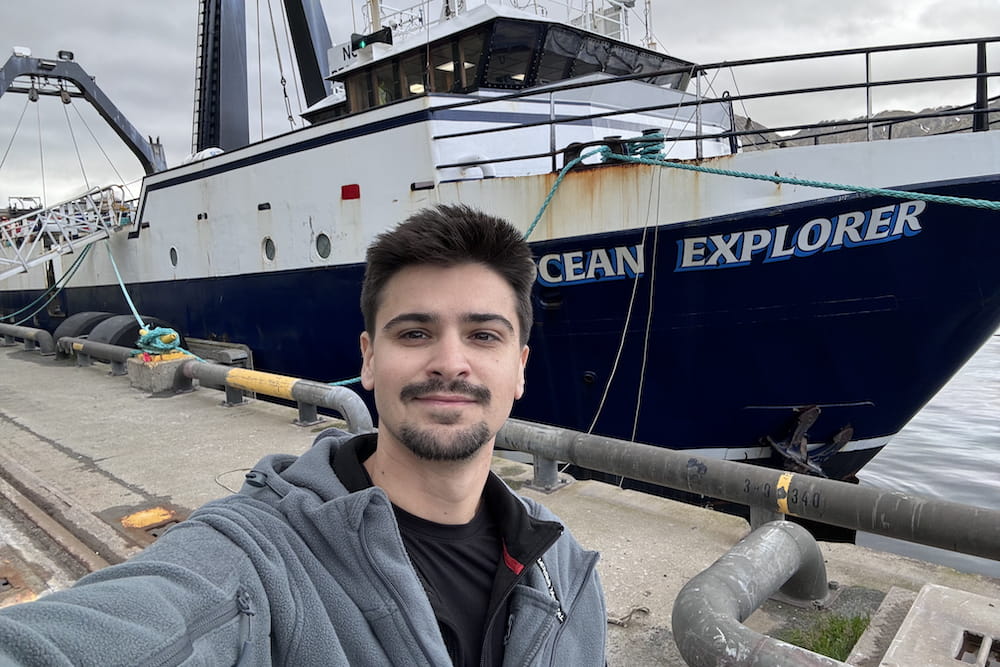Two researchers in the laboratory of Mark Hamann, Ph.D., recently returned from an expedition to the Aleutian Islands in remote southwestern Alaska.
Staff scientist Cody Dickinson, Ph.D., and natural product research specialist Menny Benjamin joined the biannual Bottom Trawl Survey of the Aleutians organized by the National Oceanic and Atmospheric Administration (NOAA) as volunteers. From June 25 to July 17, they lived and worked aboard two chartered research vessels - Dickinson on the Alaska Provider and Benjamin on the Ocean Explorer.
In exchange for their help, NOAA granted the men permission to conduct a special project to collect samples of a deep-water sea sponge. These samples are expected to improve the understanding of Aleutianamine, a promising natural compound with highly selective properties for targeting pancreatic cancer.
"Based on our assessment and the peer-reviewed literature, it is the most potent and selective molecule reported to date against pancreatic cancer," said Dickinson. "So, it's a big deal because there really aren't many good treatments at all for pancreatic cancer, and patients urgently need new options."
"The more diverse life is, the more creative the compounds become. So, biodiversity would increase the likelihood that you discover some new therapeutic through a sponge or algae that's in the deep ocean."-- Dr. Cody Dickinson
Pancreatic cancer, which is notoriously difficult to treat, is highly sensitive to this molecule. Thus, Aleutianamine may have a profound impact on the future of designing and developing better treatments for this disease. This would be critical, as currently only 12% of patients live more than five years past their diagnoses.
While the research is promising, Aleutianamine has only been tested in preclinical laboratory models of pancreatic cancer and will need to demonstrate success in further testing before advancing to clinical trials with patients. Additionally, despite its remarkable potential, acquiring this molecule presents a major problem.

Previously, samples had been collected by NOAA and delivered to MUSC for testing. The 2024 expedition marks the first time that members of the Hamann Lab went to Alaska themselves to collect the sponge since the COVID-19 pandemic.
"It's very impactful for us as researchers to go to the actual source and dredge it up ourselves," said Dickinson. "We were able to carry that from natural material all the way through to isolating the active compound from the sponge."
Dickinson's current focus at MUSC is to find a way to create Aleutianamine in the lab so he and his team can continue evaluating its use as a potential therapeutic without needing the rare sponge itself.
"In the Aleutian Islands, you have cold temperatures and immense pressure; most of these sponges are under 1,000 feet of water. You also have very low oxygen levels and the unique symbiosis with marine bacteria. All these things together create unique compounds."-- Menny Benjamin
Perfecting this synthesis has proved challenging, but with help from colleagues at the California Institute of Technology, University of Hawaii and Japan's Tohoku University, Dickinson hopes to master it yet.
This trip to the Aleutians helped to ensure that the rest of the lab could continue its research in the meantime.
"Recovering more sponge material will allow us to extract more of the compound, isolate it and then continue our biological evaluation while we're synthesizing it in parallel," he said.
With supplies replenished, the Hamann Lab is continuing its preclinical studies of Aleutianamine with the help of collaborators.
Once Aleutianamine has been chemically extracted from the sponge, or eventually synthesized in the lab, it will be administered directly to pancreatic cancer tumor cells. The researchers can then study how effectively it kills these cancer cells and, perhaps most importantly, identify the mechanism by which these tumors are made vulnerable. The compound will also be studied as a potential therapeutic for glioblastoma. Ultimately, this research will lay the foundation for future clinical trials.

While this preclinical evaluation continues, Benjamin looks to the microbiome of Latrunculia austini for clues to Aleutianamine's origin and a possible fermentation approach to drug production.
"We isolated bacteria directly from these live sponges collected on the vessel and plated them onto Petri dishes," he explained. "We hope to extract the bacteria themselves because we believe they may be responsible for making these compounds for the sponge through a unique host-microbe interaction."
Since more than 60% of anti-cancer drugs come from natural sources, including marine organisms like Latrunculia austini, it is critical to understand how compounds like Aleutianamine can arise in nature and provide novel therapeutic strategies.
And there may be a common thread to natural products with therapeutic properties: biodiversity.
"The more diverse life is the more creative the compounds become," said Dickinson. "So, biodiversity would increase the likelihood that you discover some new therapeutic through a sponge or algae that's in the deep ocean."
Benjamin agreed, adding that the harshness and unique features of the environment are important factors as well.
"In the Aleutian Islands, you have cold temperatures and immense pressure; most of these sponges are under 1,000 feet of water," he said. "You also have very low oxygen levels and the unique symbiosis with these marine bacteria. All these things together create unique compounds."
In addition, the Hamann Lab is keenly eyeing a new opportunity just off the coast of South Carolina. Earlier this year, NOAA reported the discovery of the largest deep-sea coral reef on Earth, which stretches all the way from Miami to Charleston. With some parts of the reef under 3,000 feet of icy water, this extreme region could be a treasure trove of undiscovered natural products.
"No one's studied it," Benjamin remarked. "So if we could get on an expedition with NOAA or some similar organization there, that'd be wonderful!"






